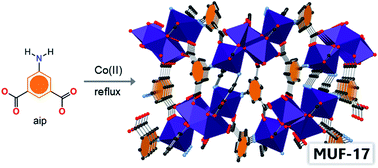A robust metal–organic framework for post-combustion carbon dioxide capture†
Abstract
Separation and purification technologies for capturing carbon dioxide (CO2) with a low energy footprint are sought after. For adsorption-based separation processes, metal–organic frameworks (MOFs) have gained increasing attention because of their tailored structures and functionalized pore surfaces. However, there are practical issues with the deployment of MOFs in industrial processes because of the lack of their long term structural stability, energy intensive regeneration and production challenges on large scales. Herein, we introduce MUF-17 as a robust MOF that combines an excellent CO2 adsorption performance and a broad suite of favorable characteristics. MUF-17 possesses one-dimensional zig-zag pores that are lined with amino and carboxylate groups enabling optimal interactions with guest CO2 molecules. Equally important, MUF-17 is easily synthesized from inexpensive starting reagents using a scalable reflux process. It is stable in the presence of water vapour. The high performance of MUF-17 and its applicability to applied settings were confirmed by breakthrough measurements in the absence and presence of humidity, multiple adsorption desorption cycles, and pelletization with a polymeric binder.



 Please wait while we load your content...
Please wait while we load your content...